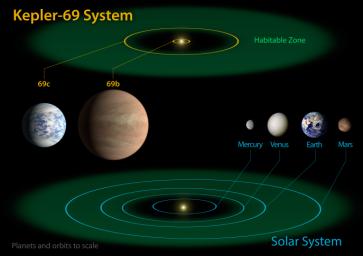
|
Kepler-69 and the Solar System
- Click the image above for a larger view
- Full-Res JPEG (3400 x 2400) (346.2 kB)
- Full-Res TIFF (3400 x 2400) (24.5 MB)
Caption:
The diagram compares the planets of the inner solar system to Kepler-69, a two-planet system about 2,700 light-years from Earth in the constellation Cygnus. The two planets of Kepler-69 orbit a star that belongs to the same class as our sun, called G-type.
Kepler-69c, is 70 percent larger than the size of Earth, and is the smallest yet found to orbit in the habitable zone of a sun-like star. Astronomers are uncertain about the composition of Kepler-69c, but its orbit of 242 days around a sun-like star resembles that of our neighboring planet Venus. The companion planet, Kepler-69b, is just over twice the size of Earth and whizzes around its star once every 13 days.The artistic concepts of the Kepler-69 planets are the result of scientists and artists collaborating to help imagine the appearance of these distant worlds.
The Kepler space telescope, which simultaneously and continuously measures the brightness of more than 150,000 stars, is NASA's first mission capable of detecting Earth-size planets around stars like our sun.
Background Info:
NASA's Ames Research Center in Moffett Field, Calif., manages Kepler's ground system development, mission operations and science data analysis. JPL managed the Kepler mission's development.
For more information about the Kepler mission, visit: http://www.nasa.gov/kepler .
Cataloging Keywords:
| Name | Value | Additional Values |
|---|---|---|
| Target | Kepler-69 | |
| System | Kepler-69 | |
| Target Type | Exoplanet | |
| Mission | Kepler | |
| Instrument Host | Kepler | |
| Host Type | Space Telescope | |
| Instrument | ||
| Detector | ||
| Extra Keywords | Artwork, Color, Infrared, Orbit | |
| Acquisition Date | ||
| Release Date | 2013-04-18 | |
| Date in Caption | ||
| Image Credit | NASA/Ames/JPL-Caltech | |
| Source | photojournal.jpl.nasa.gov/catalog/PIA17000 | |
| Identifier | PIA17000 | |
